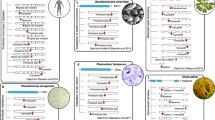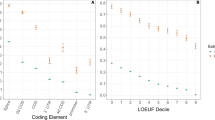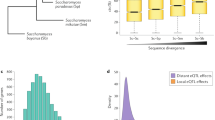Abstract
A central tenet in evolutionary theory is that mutations occur randomly with respect to their value to an organism; selection then governs whether they are fixed in a population. This principle has been challenged by long-standing theoretical models predicting that selection could modulate the rate of mutation itself1,2. However, our understanding of how the mutation rate varies between different sites within a genome has been hindered by technical difficulties in measuring it. Here we present a study that overcomes previous limitations by combining phylogenetic and population genetic techniques. Upon comparing 34 Escherichia coli genomes, we observe that the neutral mutation rate varies by more than an order of magnitude across 2,659 genes, with mutational hot and cold spots spanning several kilobases. Importantly, the variation is not random: we detect a lower rate in highly expressed genes and in those undergoing stronger purifying selection. Our observations suggest that the mutation rate has been evolutionarily optimized to reduce the risk of deleterious mutations. Current knowledge of factors influencing the mutation rate—including transcription-coupled repair and context-dependent mutagenesis—do not explain these observations, indicating that additional mechanisms must be involved. The findings have important implications for our understanding of evolution and the control of mutations.
This is a preview of subscription content, access via your institution
Access options
Subscribe to this journal
Receive 51 print issues and online access
$199.00 per year
only $3.90 per issue
Buy this article
- Purchase on Springer Link
- Instant access to full article PDF
Prices may be subject to local taxes which are calculated during checkout



Similar content being viewed by others
References
Kimura, M. On the evolutionary adjustment of spontaneous mutation rates. Genet. Res. 9, 23–24 (1967)
Levins, R. Theory of fitness in a heterogeneous environment. VI. The adaptive significance of mutation. Genetics 56, 163–178 (1967)
Moxon, E. R., Rainey, P. B., Nowak, M. A. & Lenski, R. E. Adaptive evolution of highly mutable loci in pathogenic bacteria. Curr. Biol. 4, 24–33 (1994)
Sniegowski, P. D., Gerrish, P. J., Johnson, T. & Shaver, A. The evolution of mutation rates: separating causes from consequences. BioEssays 22, 1057–1066 (2000)
Tenaillon, O., Taddei, F., Radman, M. & Matic, I. Second-order selection in bacterial evolution: selection acting on mutation and recombination rates in the course of adaptation. Res. Microbiol. 152, 11–16 (2001)
Pal, C., Macia, M. D., Oliver, A., Schachar, I. & Buckling, A. Coevolution with viruses drives the evolution of bacterial mutation rates. Nature 450, 1079–1081 (2007)
Hodgkinson, A., Ladoukakis, E. & Eyre-Walker, A. Cryptic variation in the human mutation rate. PLoS Biol. 7, e1000027 (2009)
McVean, G. T. & Hurst, L. D. Evidence for a selectively favourable reduction in the mutation rate of the X chromosome. Nature 386, 388–392 (1997)
Chuang, J. H. & Li, H. Functional bias and spatial organization of genes in mutational hot and cold regions in the human genome. PLoS Biol. 2, E29 (2004)
Braverman, J. M., Hudson, R. R., Kaplan, N. L., Langley, C. H. & Stephan, W. The hitchhiking effect on the site frequency spectrum of DNA polymorphisms. Genetics 140, 783–796 (1995)
O’Fallon, B. D. A method to correct for the effects of purifying selection on genealogical inference. Mol. Biol. Evol. 27, 2406–2416 (2010)
Bustamante, C. D., Nielsen, R. & Hartl, D. L. Maximum likelihood and Bayesian methods for estimating the distribution of selective effects among classes of mutations using DNA polymorphism data. Theor. Popul. Biol. 63, 91–103 (2003)
Drummond, D. A. & Wilke, C. O. Mistranslation-induced protein misfolding as a dominant constraint on coding-sequence evolution. Cell 134, 341–352 (2008)
McVean, G. A. & Charlesworth, B. A. A population genetic model for the evolution of synonymous codon usage: patterns and predictions. Genet. Res. 74, 145–158 (1999)
Hartl, D. L., Moriyama, E. N. & Sawyer, S. A. Selection intensity for codon bias. Genetics 138, 227–234 (1994)
Eyre-Walker, A. & Bulmer, M. Reduced synonymous substitution rate at the start of enterobacterial genes. Nucleic Acids Res. 21, 4599–4603 (1993)
Kudla, G., Murray, A. W., Tollervey, D. & Plotkin, J. B. Coding-sequence determinants of gene expression in Escherichia coli. Science 324, 255–258 (2009)
Andolfatto, P. Adaptive hitchhiking effects on genome variability. Curr. Opin. Genet. Dev. 11, 635–641 (2001)
Touchon, M. et al. Organised genome dynamics in the Escherichia coli species results in highly diverse adaptive paths. PLoS Genet. 5, e1000344 (2009)
Baba, T. et al. Construction of Escherichia coli K-12 in-frame, single-gene knockout mutants: the Keio collection. Mol. Systems Biol. 2, 0008, 10.1038/msb4100050 (2006)
Eyre-Walker, A. & Bulmer, M. Synonymous substitution rates in enterobacteria. Genetics 140, 1407–1412 (1995)
Ochman, H. Neutral mutations and neutral substitutions in bacterial genomes. Mol. Biol. Evol. 20, 2091–2096 (2003)
Beletskii, A. & Bhagwat, A. S. Transcription-induced mutations: increase in C to T mutations in the nontranscribed strand during transcription in Escherichia coli. Proc. Natl Acad. Sci. USA 93, 13919–13924 (1996)
Klapacz, J. & Bhagwat, A. S. Transcription-dependent increase in multiple classes of base substitution mutations in Escherichia coli. J. Bacteriol. 184, 6866–6872 (2002)
Francino, M. P., Chao, L., Riley, M. A. & Ochman, H. Asymmetries generated by transcription-coupled repair in enterobacterial genes. Science 272, 107–109 (1996)
Wagner, A. Risk management in biological evolution. J. Theor. Biol. 225, 45–57 (2003)
Tu, Y., Tornaletti, S. & Pfeifer, G. P. DNA repair domains within a human gene: selective repair of sequences near the transcription initiation site. EMBO J. 15, 675–683 (1996)
Hoege, C., Pfander, B., Moldovan, G. L., Pyrowolakis, G. & Jentsch, S. RAD6-dependent DNA repair is linked to modification of PCNA by ubiquitin and SUMO. Nature 419, 135–141 (2002)
Pleasance, E. D. et al. A comprehensive catalogue of somatic mutations from a human cancer genome. Nature 463, 191–196 (2010)
Lee, W. et al. The mutation spectrum revealed by paired genome sequences from a lung cancer patient. Nature 465, 473–477 (2010)
Acknowledgements
We thank M. Ackermann, S. Brenner, G. Dougan, A. Eyre-Walker, N. Goldman, B. Lenhard, J. Marioni, J. Parkhill, O. Tenaillon, C. Tyler-Smith and F. Ulhmann for their suggestions during the preparation of this manuscript. The work was funded by EMBL, the Spanish Ministry of Science and Innovation and the Caja Madrid Foundation.
Author information
Authors and Affiliations
Contributions
I.M. and N.M.L. conceived the study; I.M. designed and performed the analyses; A.S.N.S. and N.M.L. provided advice; I.M. and N.M.L. wrote the paper.
Corresponding authors
Ethics declarations
Competing interests
The authors declare no competing financial interests.
Supplementary information
Supplementary Information
This file contains Supplementary Text (see Contents for details), Supplementary Figures 1-25, Supplementary Tables 1-2 and additional references. (PDF 3270 kb)
Rights and permissions
About this article
Cite this article
Martincorena, I., Seshasayee, A. & Luscombe, N. Evidence of non-random mutation rates suggests an evolutionary risk management strategy. Nature 485, 95–98 (2012). https://doi.org/10.1038/nature10995
Received:
Accepted:
Published:
Issue Date:
DOI: https://doi.org/10.1038/nature10995
This article is cited by
-
Sequence dependencies and mutation rates of localized mutational processes in cancer
Genome Medicine (2023)
-
Re-evaluating evidence for adaptive mutation rate variation
Nature (2023)
-
Important genomic regions mutate less often than do other regions
Nature (2022)
-
Are mutations usually deleterious? A perspective on the fitness effects of mutation accumulation
Evolutionary Ecology (2022)
-
Multivariate selection and the making and breaking of mutational pleiotropy
Evolutionary Ecology (2022)
Comments
By submitting a comment you agree to abide by our Terms and Community Guidelines. If you find something abusive or that does not comply with our terms or guidelines please flag it as inappropriate.



